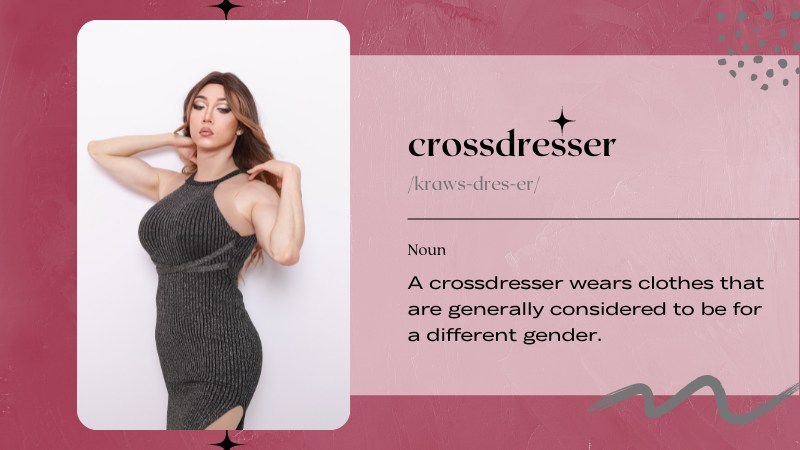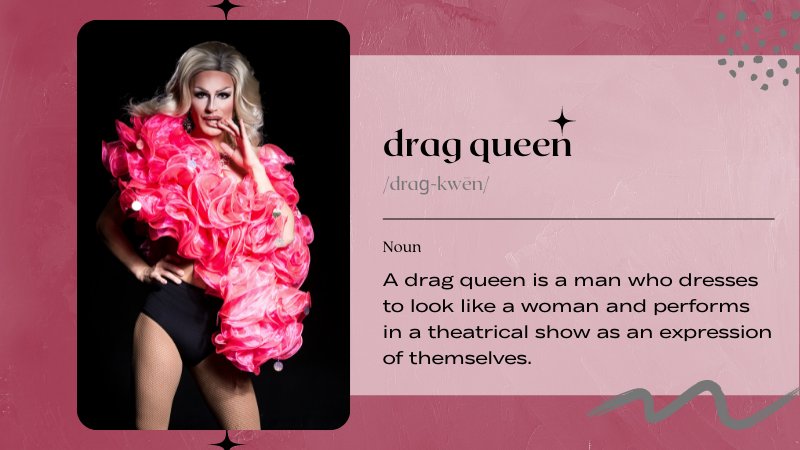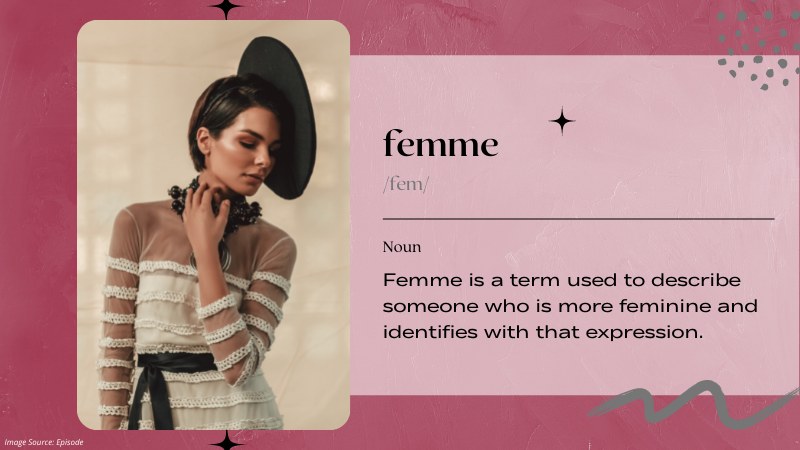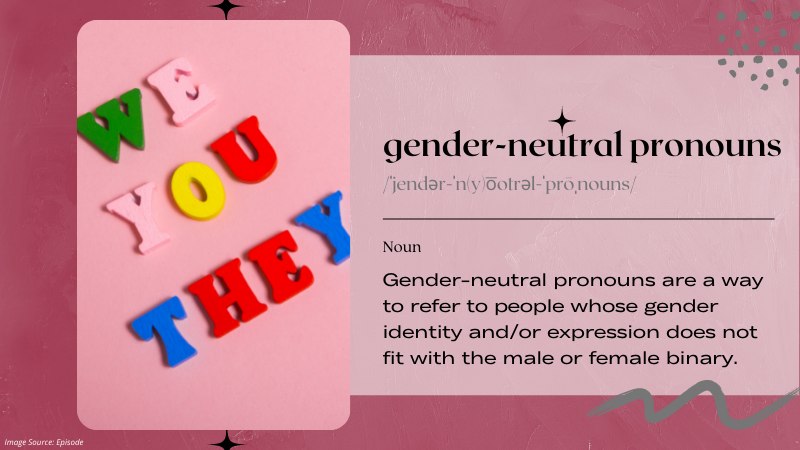Some Gender Expression Terms to Know
As crossdressers, we often face discrimination and misunderstanding from the outside world. As a result, we tend to stay silent about our crossdressing because we’re worried about what others will think about us. It’s no surprise that we have few resources to explore gender expression or even learn its terminologies. To provide more insight into this, I’ve compiled a list of some gender expression terms you should know.

Gender expression terms are the language that describes presentation, behavior, dress, and body language.
These terms are important because they help us communicate with one another on a deeper level.
There is no right or wrong way to express yourself.
There are no gender expression terms that apply to just one type of person in the world; everyone uses them, and can be expressed by anyone.
When using gender expression terms, it is essential to remember that they are NOT insults or tools of domination.
They are tools that allow us to communicate on a deeper level and see things from another person’s point of view.
This blog post will provide definitions of some common gender expression terms so you’ll have a better understanding of what’s going on in your head and someone else’s.
I’m also going to give you some tips on responding when someone uses these terms around you.
1. Crossdresser

A crossdresser wears clothes that are generally considered to be for a different gender.
They can also be referred to as “transvestites” or “transvestites who dress up.” I will use the term “crossdresser” for this article because it is much more neutral than the other terms.
Crossdressing has nothing to do with being transgender, although crossdressers make up a portion of the transgender community.
When someone is crossdressing, they are expressing their gender.
They are doing this either as entertainment or as part of a non-conformist lifestyle.
Being a crossdresser is not a sexual orientation, and it’s not something that makes someone a homosexual.
2. Cosplay

Cosplay is a very broad term that refers to the act of dressing up as your favorite character from a movie, book, video game, or anime.
Cosplayers are seen at Comic-Con and other expos around the world, often sporting homemade or purchased costumes.
Cosplay is more than just wearing the clothing; it involves creating an entire persona for yourself.
Cosplayers tend to be meticulous about their appearance and spend a lot of time making sure they have all the right accessories and props needed for their cosplay.
The word “cosplay” is a Japanese word that means “costume play.”
The term cosplay was coined in the 1980s by a Japanese hotel worker who saw people dressing up as movie characters and thought it looked fun.
3. Transgender

Transgender refers to a person’s gender identity. It’s an umbrella term used to describe people with gender identities different from the sex they were assigned at birth.
Being transgender has nothing to do with whether you’re gay or straight; it only refers to your gender identity.
You could be a transgender heterosexual or transgender gay.
Transgender people often face discrimination and social stigma for not being accepted as the gender they identify with.
You cannot tell if someone is transgender just by looking at them.
The “Transgender” label does not define a person; it merely describes their gender identity.
4. Questioning

Questioning is a word used to express that someone might be transgender but isn’t sure.
They don’t necessarily know what they’re going to do in the future regarding gender.
They don’t have an answer yet and are just exploring their options.
Questioning isn’t an insult or an attack; it’s just a way of describing the process some transgender people go through when thinking about their identity and what they want for themselves.
There is no one right path for all people questioning their gender.
It can take a long time for people to figure out what’s best for them.
It is also not unusual for people to change their minds about their gender identity over time.
If you’re ever unsure about someone’s thinking, tell them that they’re “questioning.”
5. Bigender

Bigender is a term used to describe a person who feels like they are from two genders at once.
It can be used to describe another person’s gender expression or to explain one’s own.
Being bigender doesn’t mean you’re confused about your gender; it just means that you’re in the process of exploring your many identities.
This isn’t necessarily bad, either.
For some people, different genders blend into one another like colors and don’t become apparent until there is an extreme stressor or transition.
Others have to be bigender to experience every aspect of their identity.
6. Male-to-Female (MTF)

MTF is an abbreviation that describes a person assigned the male gender at birth but identifies more as female.
There are also male-to-female transsexuals, which refers to someone assigned the female gender at birth but identifies more as male.
7. Gender fluid

Gender fluid is a gender identity option that describes a person who feels male and female at different times.
This is often considered a more “exotic” way of thinking, but it’s just as normal as being bigender or any other gender in the world.
Gender fluidity doesn’t account for all people in the world who feel like they have multiple genders within them.
It’s just another way to express your gender in a way that makes you feel good about yourself.
8. Drag queen

A drag queen is a man who dresses to look like a woman and performs in a theatrical show as an expression of themselves.
Drag queens are not transgender, although they’re often mistaken for women transitioning or trying to transition to being women.
Drag queens are primarily gay men, but they do not necessarily have to be gay or part of the LGBT community.
Some drag queens may identify as bisexual, pansexual, or heterosexual.
This doesn’t make them any less heterosexual than anyone else; it’s just one of the many types people can be attracted to.
9. Non-binary

Non-binary is an identity that refers to someone who simply does not define themselves as male or female.
This can be used in place of the terms transsexual and transgender and is sometimes used in the word “genderqueer.”
The vast majority of non-binary people are considered transgender, but it’s not necessary to always be transgender.
Most non-binary people probably feel like they are somewhere between male and female, but gender theory tends to get complicated when there are more than two genders.
10. Femboy

Femboy is a gender expression that describes a person who feels like a boy.
This doesn’t necessarily mean that they are transgender, but it can be used as an adjective to describe someone who identifies as more feminine.
This can be used as a more “aggressive” way of describing heterosexual men who hang out in a feminine space, including fashion and music.
Femboy can sometimes also refer to someone who was assigned female at birth but identifies more like a boy.
11. Femme

Femme is a term used to describe people who feel like girls.
It can also be used to describe someone who is more feminine and identifies with that expression.
Being feminine isn’t always about being a girl; it’s more about the identity you choose for yourself.
Similar to how someone who has a more feminine gender expression can be described as a femboy, someone who has a more masculine gender expression can be described as an “aggressive” gay man or queen.
12. Queer

Queer is a term used to describe someone who isn’t interested in the “normal” gender binary.
It’s a way of expressing that you’re not straight or cisgender.
There are many different terms and ideas when defining sexuality and gender, so queer is just one identity that some people choose to use.
Some people use this term because they don’t agree with the idea of labeling themselves as gay or lesbian, for example, so they use queer as more of a descriptive term for themselves.
13. Gender-neutral Pronouns

Gender-neutral pronouns are a way to refer to people whose gender identity and expression do not fit with the male or female binary.
These pronouns are different from queer pronouns, which only describe sexual orientation.
Gender-neutral pronouns include they, theirs, hers, they’re, theirs, and others.
Gender expression and identity are not set in stone and can change over time.
The terms many of these identities can be used to describe can vary, so it is important to look up the specifics of what each identity means and how it is used.
This can also help you understand your own identity better.
You should not be limited by what someone else thinks about you or how you look, though.
If you identify with an identity and feel comfortable being yourself, that’s all that matters.

Another important note is that some people use more than one term to describe who they are and how they identify with their gender expression.
The most important thing is to be yourself and love yourself unconditionally, regardless of how others label or define you.
Tagged With:Gender expression , Gender terms
- What is a Crossdresser? Understanding the Behavior, Its Origins, and Social Context
- Crossdresser vs. Transgender: What’s the Difference and Why Does It Matter?
- Why Do Some Straight Men Enjoy Crossdressing?
- 7 Best Mtf Trans and Crossdresser Podcasts in 2024
- Journey With Roanyer : Your Beginner Crossdressing Store
- The Intersection of Cosplaying and Crossdressing
Established in 2009, We are a recognized manufacturer and seller of professional crossdressing products.
It is our aim to become not just the most creative manufacturer but also a very considerate seller, as we provide the best quality products for crossdressers all around the world.























 Breast Forms
Breast Forms  Body Suit
Body Suit  Realistic Mask
Realistic Mask  Femini Girdle
Femini Girdle Hip & Butt Enhancement (8)
Hip & Butt Enhancement (8) Penis Prosthesis
Penis Prosthesis Fake Muscle
Fake Muscle Bikini
Bikini  Wig
Wig  Corsets
Corsets Course
Course service@roanyer.com
service@roanyer.com +8618652200711
+8618652200711 Facebook
Facebook YouTube
YouTube Twitter
Twitter Instagram
Instagram




